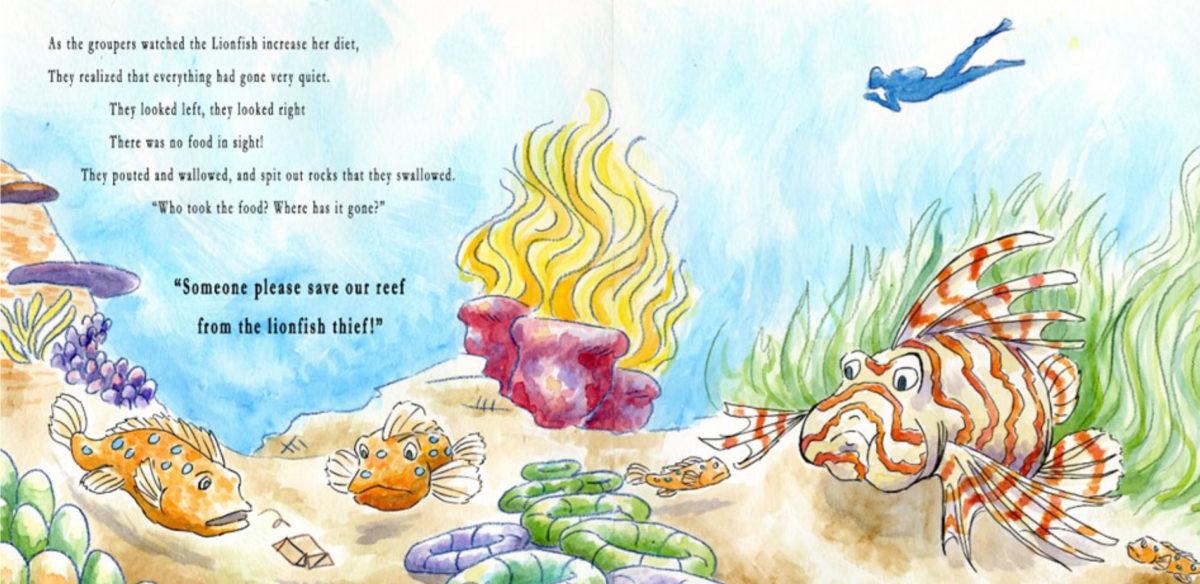Teaching Award Runner-up
Martha Carothers
Professor
University of Delaware
Students created visual storybooks to communicate scientific methods and principles about the ocean and aquatic life to children. The five storybooks teach the scientific findings of published research on tropical coral reef lionfish to children age three to seven. The concept of each individual storybook focuses on a single research finding. Marine Science, Art & Design, and Psychology students in an interdisciplinary course format (three-student teams) created and evaluated the effectiveness of the visual storybooks.
Professors Martha Carothers (Art & Design), Danielle Dixson (Marine Science), and Agnes Ly (Psychology) initiated the storybook course to establish the framework for teaching communication through creative expression, utilizing the skills and expertise throughout the University. Science-based children’s storybooks began with learning how to read a scientific paper, understanding the research findings, and developing a concept map. This was followed by developing the storyline from the concept map and writing the story. Next was illustrating the story, designing the storybook, and producing the hardcopy. The efficacy of the creative, non-traditional communication efforts was evaluated by quantitative data collection during story hours with children.
The long-term outcome of this course is to establish an interdisciplinary and information- synthesis capstone experience to promote engaged, experiential learning that fulfills multiple general education objectives: (1) engage in constructive ideation, (2) to communicate effectively in writing, orally, and through creative expression and (3) work collaboratively and independently within and across contexts and differences, and (4) reason quantitatively and scientifically. These objectives prepare students to meet the broader goal of becoming “engaged citizens, involved in the world around them, and who understand the major challenges and debates of the day.” (University of Delaware General Education Objectives 2014)
Scientific research is front-page news. Sea-level rise, biodiversity loss, climate change, and the collapse of sustainable food sources are some of today’s most pressing news topics facing policymakers, researchers and the general public. A basic understanding of these issues is critical to the overall protection of environmental capital, ecosystem services and society as a whole1. The interdisciplinary scientific principles underlying these topics should therefore be a primary goal of education for our undergraduates.
The storybooks build on previous research indicating that reading aloud with young children is considered one of the best predictors of children’s early reading success2 and despite a scarcity of information books in elementary classrooms, non-fiction reading material plays a role in building children’s background knowledge and vocabulary in content areas3, 4, 5. Therefore, the development of specific science-based picture books could increase awareness for conservation initiatives at an early age, create the mindset of environmental consciousness, and increase early exposure to STEM fields6.
- President’s Council of Advisors on Science and Technology (PCAST) (2011) Sustaining Environmental Capital: Protecting Society and the Economy.
- Neuman SB, Copple C and Bredekamp S (2000) Learning to read and write: developmentally appropriate practices for young children. Washington DC: National Association for the Education of Young Children.
- Brabham E, Boyd P, Edgington WD (2000) Sorting it out: elementary students’ response to fact and fiction in information storybooks as read aloud for science and social studies. Reading Research and instruction, 39: 265-290
- Duke NK (2000) 3.6 minutes per day: the scarcity of informational text in first grade. Reading Research Quarterly, 35: 202-224
- French L (2004) Science as the center of a coherent, integrated early childhood curriculum. Early Childhood Research Quarterly, 19: 138-149
- Leung CB (2008) Preschoolers’ acquisition of scientific vocabulary through repeated read-aloud events, retellings and hands-on science activities. Reading Psychology 29: 165-193
https://www.art.udel.edu/news/Pages/SCIENCE-THROUGH-STORYBOOKS.aspx
http://delawarepublic.org/post/simplifying-science-udel-students-create-children-s-books-research
http://www.udel.edu/udaily/2017/april/science-storytelling/
http://udreview.com/new-class-engages-children-in-science-through-storybooks/
Martha Carothers is Professor of Art & Design at the University of Delaware where she teaches visual communications, typography, book arts, and foundation design. Carothers’ book arts often highlight text about books, reading, and typography. Her artist’s books are letterpress, hand bound, and computer generated under The Post Press. Carothers’ creative work has been exhibited internationally and is included in national and private collections. Carothers’ graduate graphic design research at Penn State University focused on pop-up and moveable books. She continues to research conceptual design and illustration in children’s books. Carothers directed study abroad programs between 2002-2010 to Australia teaching design in the visual arts and introductory digital photography. Carothers was a 2011-2012 Fulbright Scholar affiliated with the City University of Hong Kong.
Recipient of recognition in the Design Incubation Communication Design Awards 2017.
